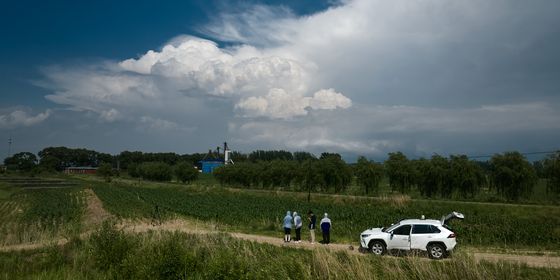Is World Heritage status really about preservation or tourist dollars?
A small island approximately 20 minutes by boat from Xiamen, Fujian province, Gulangyu has long been a popular attraction for tourists who flock to its pedestrian-only streets for a taste of colonial-era China. Last weekend, it was named an Historic International Settlement at the 41st session of the World Heritage Committee in Poland for its “mixed architectural characteristics from the local, Southeast Asian, and Western styles.”
A “major gateway in early-stage globalization,” according to China Daily, Gulangyu’s UNESCO designation is the result of a year-long campaign to recognize what Song Xinchao, deputy director of the State Administration of Cultural Heritage, calls its “deep traditional Chinese culture roots and inclusiveness to embrace different values and cultures.”
Also added to China’s list of World Heritage Sites was Qinghai Hoh Xil, an uninhabited 45,000 square-kilometer area on the Qinghai-Tibet Plateau that is home to the once-endangered Tibetan antelope and more than 200 other wildlife species (thanks to anti-poaching efforts which began eight years ago, Shanghai Daily reports that the region now has 60,000 antelopes).
Yet while local tourism chiefs toast the news—a UNESCO designation is acknowledged as a way of boosting tourist numbers—critics warn that designation can prove detrimental for developing countries which struggle to balance conservation with commerce.
The UNESCO World Heritage Committee meets once a year to choose natural or manmade additions to a list made according to certain criteria. Designation is supposed to protect and conserve the unique phenomena found at the site—yet achieving World Heritage status is often no guarantor of protection or maintenance, either for the sites or neighboring areas.
Angkor Wat in Cambodia, elevated to World Heritage status in 1992, draws an annual 2 million visitors, but Francesco Bandarin, director of UNESCO’s World Heritage Center, has acknowledged that “nobody looked at the urban explosion that was happening in Siem Reap” nearby. The former backwater has become a sprawling tourist trap of hotels, restaurants, bar streets, massage parlors, souvenir markets, nightclubs, and an airport. “From the Great Wall of China to the Pyramids of Egypt, some of the world’s most amazing sites are being overrun by tourists,” notes travel writer Jim Cheney, reflecting on the impact of UNESCO status: It “detract[s] from their historical importance…destroying the local way of life.”
One small village in southern China experienced the downsides of UNESCO status firsthand. Zili Village (自力村) of Kaiping city, Guangdong, was once home to Kaiping watchtowers—Baroque turrets dating back to the early 20th century, when villagers needed protection from civil strife and marauding bandits—but now locals must deal with an endless stream of tourists, led and plied with “peasant family food” and “rustic bamboo” souvenirs by tour guides.
Chris Ryan, a professor of tourism at the University of Waikato in New Zealand, told CNN that “World Heritage status is increasingly being used as an economic vehicle to develop backward regions.” CNN claims that much of the tourist dollars in Zili have gone into building more car parks, ticketing booths, and other tourist-led facilities, rather than preservation or protection of the actual site. “The World Heritage emblem has come to represent a grandiose marketing tool—fodder for ‘things to see before you die’ coffee-table books,” notes Simon Usborne in the Independent.
For Beijing, a cautionary lesson can be found close to home: In 1987, when the Forbidden City was granted World Heritage status, authorities set about destroying hundreds of the surrounding hutongs that were deemed unsightly to visitors—today, what remains of these traditional alleys have become cherished attractions. Although sometimes gaudily restored and congested, they remain the last vestiges of a manic modernization drive that many already regret.
Similarly, large sections of the Great Wall have been rebuilt to accommodate an annual 10 million visitors, with the addition of cable cars, toboggan rides, and innumerable cafes and restaurants (including a Burger King). In 2015, state media reported that one third of the Great Wall has disappeared due to both natural erosion and human activities. “You have to ask what you are conserving,” observed Zhang Jie, professor of architecture and urban planning at Tsinghua University. As travel writer Michael Meyer laments in his book, The Last Days of Old Beijing, “Beijing’s heritage has vanished throughout the last century, as economic and political changes altered the city’s appearance and lifestyle.”
But even if restoration or conservation is often off the table, many sites actually receive less protection once granted heritage status: Per China Daily, local officials often view “being included on the list as a goose that lays a golden egg, instead of an inspiration to better protect cultural relics.”
Zhangjiajie National Forest Park in Hunan province was listed as a World Heritage Site in 1992 but has since received an official warning about the number of newly constructed buildings. Meyer, who also helped to train UNESCO site managers in China, argues that World Heritage Sites are “collected by China the way actors chase Oscars. They are a validation of possessing ‘culture’ and an economic boon via tourism.”
Speaking after the latest additions, Liu Yuzhu, head of China’s State Administration of Cultural Heritage said, “Along with more sites being recognized for their cultural value, comes greater responsibility and more duties.” Only time will tell if the architectural appeal of Gulangyu and the natural wonders of Hoh Xil can withstand the human activity that inevitably comes with heritage status.












